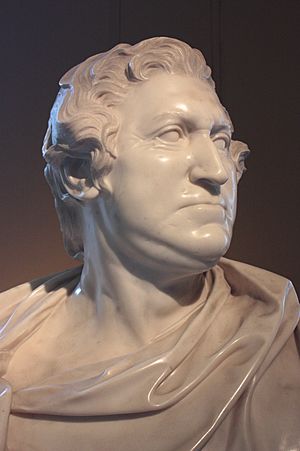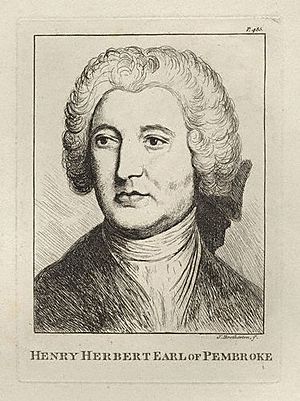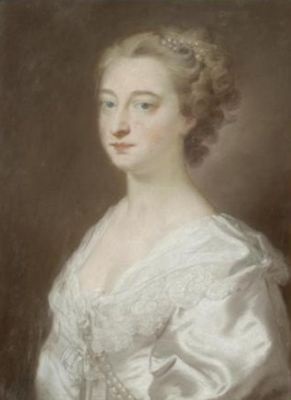Henry Herbert, 9th Earl of Pembroke facts for kids

Henry Herbert, 9th Earl of Pembroke (born January 29, 1693 – died January 9, 1749) was an important English nobleman. He was also known as the 6th Earl of Montgomery. He was the oldest son of Thomas Herbert, 8th Earl of Pembroke.
From the time he was born until 1733, people called him Lord Herbert. Then, he inherited his father's titles, becoming the Earl of Pembroke and Montgomery. He also worked for King George II of Great Britain, serving as a Lord of the bedchamber.
Contents
Life of a Nobleman
Henry Herbert went to Christ Church, Oxford to study. In 1712, he took a "grand tour" of Europe. This was a common trip for young noblemen to learn about art and culture. He visited cities like Naples, Rome, and Venice.
He became a close helper to King George II. This was when George was still the Prince of Wales. In 1715, Henry became a deputy lieutenant in Worcestershire. He also joined the military, becoming a captain in the Coldstream Guards in 1717. By 1721, he was promoted to colonel. He led the 1st Troop of Horse Guards.
When George II became king in 1727, Henry stayed close to him. He was made the first lord of the bedchamber. After he became an Earl in 1733, he left the Horse Guards. He then became a colonel of The King's Own Regiment of Horse. Later that year, he was made Lord Lieutenant of Wiltshire. This meant he was the King's main representative in that area.
King George II really liked Henry. In 1735, Henry became a groom of the stole. This was a very important position in the royal household. He also joined the Privy Council of Great Britain. This group advised the King. Henry tried to help the King and his son, Frederick, Prince of Wales, get along, but it didn't work out. Even though he was powerful in his local area, Henry didn't play a huge role in national politics.
An Architect Earl
Henry Herbert loved old things, just like his father. But instead of collecting, he loved designing buildings. He was known as one of the "architect earls." He designed seven buildings, though two of them are no longer standing.
He worked with another architect named Roger Morris. Together, they designed several famous buildings. These include Marble Hill House (built 1724–1729) and the White Lodge, Richmond (built 1727–1728). He also designed the beautiful Palladian Bridge at Wilton House. This bridge goes over the River Nadder. He also designed a water tower at Houghton Hall. It looked like a garden temple.
Henry was a big supporter of building Westminster Bridge in London. He helped get the law passed in 1738 to build it. He even laid the first stone in 1739. He went to many meetings about the bridge. He strongly supported its designer, Charles Labelye. Even when parts of the bridge had problems, Henry believed in the design. He was proven right in the end.
Henry was a very active person. He loved swimming and played tennis every day. He was strong and healthy. He became a lieutenant-general in the army in 1742. In 1743, he became a Fellow of the Royal Society. This is a group for important scientists. He died in 1749 at his home, Pembroke House.
Unusual Diet
Henry Herbert was known for his very unusual diet. He tried to eat only beetroot and watercress. He even carried these foods in his wig, using it like a small bag! In 1729, people saw him walking in Paris, eating his beetroot and watercress. This diet was very unhealthy, and he almost died from it.
Some people have called him a "pioneer vegetarian" or even a "proto-vegan." A historian named James Lees-Milne said that Henry "became a fanatical vegetarian to the extent of practically starving himself to death."
Family Life
Henry Herbert married Mary FitzWilliam on August 28, 1733. She was the oldest daughter of Richard FitzWilliam, 5th Viscount FitzWilliam. They had only one child, a son named Henry. This son later inherited his father's titles.
When the Fitzwilliam family line ended in 1833, the Pembroke family inherited a lot of land in Dublin. They still own much of this land today.
Gallery of Architectural Works







